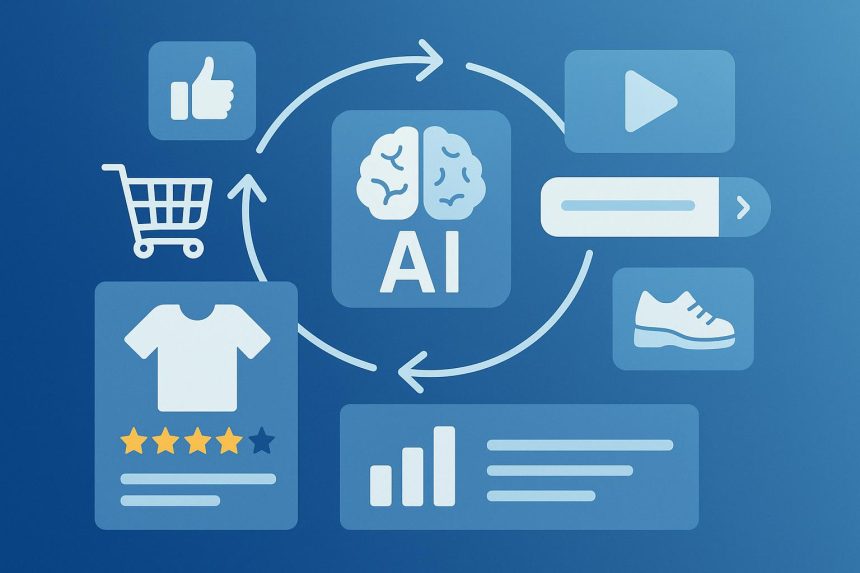Many businesses struggle to make marketing messages feel relevant. In email programs and online catalogs, generic offers often miss the mark. Recipients skip messages, carts fill without checkout, and inventory lingers on shelves. Personalization is not a nice-to-have; it is a practical response to crowded customer attention. When recommendations match interests and timing, engagement rises, and marketing spend works harder. An AI-powered recommendation engine often provides this level of relevance.
For companies looking for a ready path to better personalization, an effective product recommendations engine can be a direct solution. It helps surface the most relevant items to each customer, making emails, site pages, and checkout flows more useful and more likely to convert. Many teams begin by evaluating a product recommendations engine for starter gains.
Why Relevance Changes how Customers Act
People respond to value. When a message highlights something a shopper actually wants, they pay attention. Simple rules like “recently viewed” do some work, but better outcomes come when suggestions reflect real patterns: What a shopper explored, what similar buyers chose, and what they have bought before.
When recommendations match taste and need, the customer feels understood. That feeling builds trust, and trust reduces friction on later visits. Over time, those small moments of relevance add up: customers come back, and marketing costs to get new buyers fall. Many retailers rely on an AI-powered recommendation engine to spot the right patterns quickly.
What an AI-Powered Recommendation Engine Brings
An AI-powered recommendation engine looks at many small signals, past purchases, pages a person saw, time spent on items, and links between products, and combines them to suggest things a shopper is likely to want. It replaces constant manual lists with a system that learns and updates. If interest shifts from one category to another, the suggestions change too.
This adaptability keeps messages fresh without a team spending hours on lists. It also helps avoid repeating the same suggestions until customers tune out. For marketing teams, that means more time for creative campaigns and testing, and less time spent curating static recommendations.
Real Business Wins That Follow
There are clear, measurable gains from useful suggestions. First, average order values usually go up. When suggested items fit the purchase, cross-sells and add-ons convert more naturally. Second, cart abandonment often occurs. Follow-up messages that include the exact items left behind, or in-stock alternatives, bring many shoppers back. Companies that test AI product recommendations often report clear lifts in average order value.
Third, inventory moves more smoothly. A product recommendations engine can push items that need attention or suggest small bundles that clear slow stock without deep discounts. Fourth, repeat purchases increase. People who consistently find value return more often, and returning buyers cost less to acquire than new ones.
How Different Sectors Use Recommendations
Different industries apply recommendations in different ways. Retail and eCommerce use them everywhere: On home pages, on product pages, and inside emails. A fashion retailer can suggest matching pieces to complete an outfit; a grocery site can remind a shopper to reorder a staple.
Travel and hospitality use the same idea: Suggest seat upgrades, local experiences, or convenient extras based on past trips. Media and streaming services and platforms often rely on recommendations to keep viewers hooked. Even B2B sellers benefit: suggesting compatible parts, maintenance packages, or add-ons simplifies purchasing for busy buyers.
Small Teams Can Start; Large Firms Can Scale
Many assume these systems are only for big companies with large data teams. That belief is outdated. Today’s offerings let small businesses begin with simple setups that use the data they already have, sales records and web events, and see quick improvements. Startups can leverage AI product recommendations without a large data team.
Larger organizations can grow from that point, adding loyalty data, in-store purchases, and complex inventory rules. Providers commonly offer tiers, so teams can add capabilities over time once early wins justify broader rollout.
Practical Steps to Start, Without Heavy Risk
Getting started should be low-effort and measurable. First, prepare clean data. That means a tidy product catalog (unique IDs, accurate prices, clear categories, up-to-date stock status), recent sales records, and basic web events such as viewed items, add-to-cart actions, and completed purchases. Include simple metadata for products, brand, category, size, color, and any attribute that matters to customers so recommendations make sense. Run a quick data check to spot missing IDs, duplicate SKUs, or mismatched prices; fixing those few issues prevents poor suggestions later.
Second, it is advised that you run a short pilot as a full rollout is intensive. Pick a few high-impact places to test two or three email types (welcome, cart reminder, post-purchase), and a couple of key pages (product page widget, cart page). Use a representative slice of visitors and customers so results reflect real behavior. Keep the pilot scope limited so it’s easy to manage: one channel at a time or one set of product categories. Include an A/B test or holdout group so the team can compare performance to the current approach and see a clear lift before expanding. An AI-powered recommendation engine often uses basic filters and collaborative signals at first.
It is also advised that you add richer signals in stages and expand thoughtfully. Once the pilot shows positive movement, roll recommendations into more emails and more pages. Then layer in extra data sources gradually: loyalty tier, purchase frequency, in-store sales, or customer support interactions. Introduce business rules as needed (for example, avoid promoting out-of-stock items or exclude items with very low margins). Keep changes incremental so the team can spot which new signals drive further improvement.
Make sure the product catalog and business rules align so the system does not promote unavailable items.
Common Worries, and Plain Answers
Privacy and data use are valid concerns. The simplest path is transparency: Explain how suggestions are generated and offer clear opt-out choices. Cost can be addressed by starting with a pilot; many vendors support small-scale trials. Technical complexity is often less than expected; integration guides and plug-and-play tools make setup manageable for most teams. Trials can show how AI product recommendations behave before full deployment.
Bottom Line
A well-chosen AI product recommendations solution turns routine customer actions into helpful suggestions. That shift improves how customers experience emails and site pages, reduces abandonment, moves inventory more reliably, and raises repeat business. Across retail, travel, media, and B2B, a focused product recommendations engine delivers measurable gains. Ultimately, an AI-powered recommendation engine is a practical tool for steady growth.
Lynn Martelli is an editor at Readability. She received her MFA in Creative Writing from Antioch University and has worked as an editor for over 10 years. Lynn has edited a wide variety of books, including fiction, non-fiction, memoirs, and more. In her free time, Lynn enjoys reading, writing, and spending time with her family and friends.















